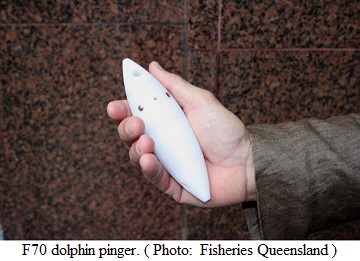New alarms warn dolphins to steer clear of shark nets
News Release
Fisheries Queensland
Department of Agriculture, Fisheries and Forestry
23 July, 2012
New acoustic alarms are being trialled on the Gold Coast and Rainbow Beach north of the Sunshine Coast to help reduce the number of dolphins caught in shark control equipment.
The alarms, known as pingers, have been attached to six of the 11 shark nets on the Gold Coast and two of the three nets at Rainbow Beach.
Shark Control Program Manager Jeff Krause, from the Queensland Boating and Fisheries Patrol, said no dolphins had been caught in these nets since the new pingers were put in place in April this year.
“As with any trial of this nature the pingers will be in place for some time so we can properly determine their effectiveness, but these early results are promising,” Mr Krause said.
“In the past we’ve had some success with other types of pingers in reducing the number of dolphin entanglements, but we’re hoping these new pingers will be even more successful.
“If these pingers are as effective as we hope they will be, we’ll then look at installing them at other beaches with shark nets in place along the Queensland coast.”
The alarms are developed by Fumunda Marine, a Sunshine Coast-based specialist marine mammal acoustic pinger manufacturer.
Director of Fumunda Marine, James Turner said earlier pingers were designed to target harbour porpoises, prevalent in the northern hemisphere.
“These new pingers work differently to the porpoise pingers and are designed specifically to alert dolphins to the presence of the shark nets.
“The earlier porpoise pingers do work on some dolphin species but these new pingers are more powerful and deliver a louder signal, as dolphin species are larger and more robust than porpoises.
“The pingers operate at 70 kHz, which sits right in the best known middle hearing range of bottlenose and common dolphins, both of which are found in Queensland.
“This frequency is far higher than the 10 kHz used in the earlier porpoise pingers.”
Mr Krause said while the main priority of the Shark Control Program was to improve safety for beachgoers, a range of measures were in place to reduce the number of marine animal entanglements.
“Whale pingers have been used on shark control nets since 1993 and since then research and development has continued and a new type of whale pinger was most recently introduced in 2010,” Mr Krause said.
“Given we’re expecting to see up to 16,000 whales migrating along the coast this season, it’s important we continue to take preventative measures to help them avoid entanglements.
“We also have specially trained Marine Animal Release Teams on the Gold Coast, Sunshine Coast and in Mackay.
“A volunteer whale observer program is in place on the Gold Coast and Sunshine Coast, whereby people living in high-rise buildings are trained to identify whale entanglements in shark control gear if they occur.
“Surveillance cameras are also mounted on buildings at the Gold Coast, Sunshine Coast and Rainbow Beach to help monitor and check reported marine animal entanglements.
“Some changes to the locations of nets and drum lines, types of hooks and bait since the introduction of the program have also improved our ability to target key species while reducing non-target catch.”
Anyone who spots a whale or other marine animal tangled in fishing gear or shark netting should call the 24-hour Shark Hotline on 1800 806 891.
Source: Fisheries Queensland.

I wonder if they have valid statistics on how many Dolphins are caught in these nets as well as other marine life other than sharks.
I’m a commercial fisherman and have a problem with pilot whales getting near or on my gear . I’ve been thinking about pingers to reduce or stop interaction with the whales. Is there anybody that has data on what the range of the pingers effectiveness is?